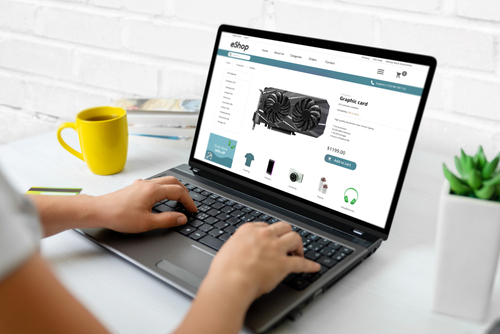In 2023, it’s estimated that eCommerce will account for nearly 21% of all retail activity. This means one in every five sales will be done online. By starting an eCommerce business, you can take advantage of these sales.
But if you are like most people, you don’t know where to begin. To help you out, check out this nine-step process for starting your first eCommerce business in 2023.
The seven steps of starting an eCommerce business in 2023
1. Find a niche and product
The first step to any good eCommerce business is finding something to sell. This means finding a niche and product.
A niche is an overall category of different products to sell. By sticking to one type of product category, you can better understand the nuances of that industry.
It also helps to pick something you have a personal interest in. After all, you are more likely to be successful if it’s something you are passionate about.
A good niche has a lot of opportunity and is often underserved by current sellers. You might’ve identified an area of demand not being met with great expansion potential into other products.
Good products within that niche include those that are lightweight (to save on shipping), easy to use (to avoid frustration), and difficult to break (to reduce returns).
You should also avoid selling electronics and mechanical products, with both coming with their own frustrations. Once you get some experience in online sales, you might revisit selling more complex products.
Here are some research tools you can use to help find good products:
- Google Trends (tells you how the product performs historically)
- Amazon Best Sellers (tells you how the product performs overall)
- Amazon Movers & Shakers (tells you how the product performs in the short term)
Be sure to take the time to research if any of your products require a license. Most online businesses don’t need a license to sell in the UK, but it’s better to check your niche before assuming. Factor this in during your profit analysis during the next step.
2. Do competitive research
The second stage of the product research process is competitive research. Knowing your competition helps you identify how viable the market is.
When looking at your competition, focus on these areas:
- Number of sellers (take a look at the number of people selling in the industry)
- Historical sales (look at the history of sales and how long some competition has been there)
- Profit potential (look at how much your competition generally sells for and whether you can compete with that price)
- What they sell (look at what they currently sell and ask yourself how you can be unique)
An overall competitive research process lets you know whether you can compete. Ultimately, to be competitive, you need to sell a unique product to stand out. You also need to be sure you can make a good enough profit margin to justify entering the market.
3. Choose a platform for selling
Once you decide on a product and niche and determine whether you can enter the market, you need to determine how to sell it. The two general platforms you can choose from include those in third-party marketplaces and your site.
Third-party marketplaces include websites like eBay and Amazon. They are considered the least expensive starting option because you don’t need to generate traffic.
You know the traffic is there, you just have to pay for advertising to get attention. Eventually, as your product becomes a proven staple, these platforms will feature your products on their site for free (typically through a search engine).
The problem with this model is that you don’t own any of the traffic. This means if the site decides to feature a competitor, you don’t have control over where that goes. This uncertainty can push people to choose option two: building their own eCommerce website.
Having your own website comes with some distinct advantages. The most significant advantage is that you own the traffic, meaning you don’t have to share featured product space with your competitors. This typically means more sales for you.
Alternatively, because you control the traffic, you need to build your site’s authority. To start, this often means needing to pay much more for advertising. Alternative forms of website building, like SEO, can be helpful in the long run but generally don’t provide you with short-term profits.
Regardless of your choice, educate yourself on the different forms of advertisement across these platforms. You’ll need to use them to help people find your products, especially when you are starting.
4. Choose a business model
Your business models might also dictate the type of product and how you want to sell it. Below are some of the most standard eCommerce sales methods you can choose from and a short review of the pros and cons:
- Private label. You choose a manufacturer and resell the products under your unique logo. This method requires more product testing but gives you the highest potential for online recognition.
- Wholesale. You choose a well-known brand and resell their products after bulk purchasing. This requires a higher upfront investment and doesn’t let you build a personal brand.
- Dropshipping. When you resell products fulfilled by a third-party supplier. No management of products is required, but you have no control over the quality of the product.
- Online/retail arbitrage. When you find discounted retail products (either in online or physical stores) and resell them at a markup. This selling method requires a lot of legwork but can result in good short-term profits.
5. Find suppliers
The selling strategy you choose dictates the suppliers you find. Below are a few good ways you can find reputable suppliers.
- Alibaba is an ideal solution if you are looking for manufacturers. This is an excellent solution for private label manufacturers.
- Dropshipping suppliers include sites like Aliexpress and Oberlo. Using these sites will connect you with reputable businesses, many of which also have built-in reviews from fellow users.
- Wholesale distributors are the major brands behind different niches. If you want to get into wholesale, you’ll reach out to the major brands you are interested in selling for.
- Google search provides a few options for checking the reputation and finding more distributors. Always check out Google reviews and other resources before choosing a distributor.
6. Manage shipping
After picking a distributor, you’ll need to figure out how to manage shipping. Typically, you’ve got three options when it comes to this category.
First, you can choose a solution that’s managed for you. Two examples of these hands-off options are for those who want to sell on Amazon or dropship.
Third parties entirely handle dropshipping. Meanwhile, Amazon has a popular service known as FBA (Fulfillment By Amazon). FBA sellers let Amazon handle their warehousing and shipping, letting sellers focus elsewhere.
Second, you can choose to handle the shipping yourself. You’ll either hire a fulfillment assistant (which can be expensive) or do it yourself (which can be time-consuming). Handing it off to someone else is often better, as it becomes challenging to run a business when you are stuck with backend duties.
Third, you can outsource your shipping services, which you might do if you own an individual site. In cases where you don’t know much about logistics, this is often the best option. However, this can get somewhat expensive.
Examples of companies that handle this include Pirate Ship, Shippo, and Bolt Fulfillment. For other companies, be sure to check online reviews before picking someone.
7. Set up internal processes
As your business grows, you’ll need to create a system for different parts of it to run. After all, without a system, certain aspects of your business will get out of control.
For example, if you don’t have a regular system for reviewing the market, you might not be ready for competition. Another seller could take a similar approach that you did to enter the market. This will cause you to lose sales, giving them to your competition.
You can also apply the same idea when speaking to manufacturers, making announcements to your customer service team, or adding new members to your eCommerce empire. Ultimately, it all comes down to discussing what steps to take next.
Conclusion
When starting an eCommerce store, it’s best to start small. With these seven steps, you can simplify your process and avoid overcomplicating things. You can apply these lessons whether you dropship, sell on Amazon, or own a custom figurines shop.
Regardless of how you sell, go out and try new things. The best way to learn is to try, but be sure to research so your “try” can turn into results quickly—best of luck.





